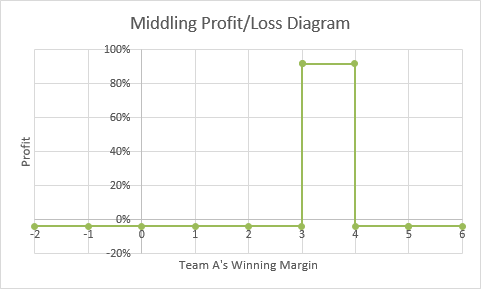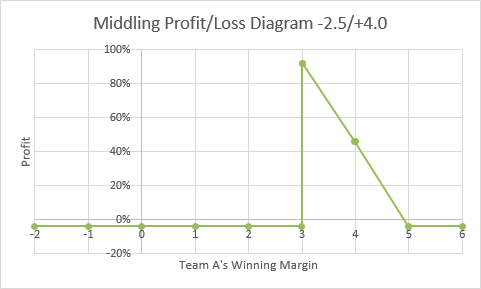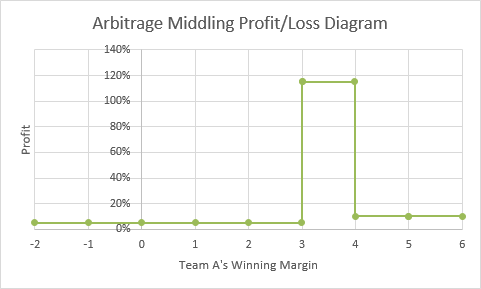You are here: Home >> Beginner’s Guide >> Betting Strategies >> Middling
A Middle is a betting strategy that takes advantage of shifts in lines or total score markets. The act of engaging in this strategy is called middling. A middle consists of two opposing line or totals wagers on the same market. The two bets are placed at different lines or totals such that there’s a chance that the final score will fall in the middle of the two numbers, meaning both bets will win. Because the two wagers are on opposing outcomes at least one wager will win, which limits the downside risk.
The opportunity to middle can arise either because bookmakers have simultaneously published contrasting lines or because the line has shifted since a wager was placed.
Line Middles
An opportunity to middle arises in a line market if:
1) You back the favourite and the line shifts to give the underdog a bigger head start
or
2) You back the underdog and the line shifts to give the underdog a smaller head start
A quick way to know if a middle exists is to take the sum the two lines and see if it exceeds zero.
Suppose you placed the following two line wagers:
Bet 1: Team A -2.5 at 1.92 odds
Bet 2: Team B +4.5 at 1.92 odds
If Team A were to win by 3 or 4 points, both line wagers would win. As is the case with all line middles, there is a chance that both wagers will win because more points are given to the underdog than are taken away from the favourite. Most literature on this topic discusses line markets exclusively, however you can combine a head-to-head wager with a line bet because a head-to-head wager is effectively a +0.0 line bet.
Using the example above, if you were to wager one unit on Bet 1 and one unit on Bet 2 your profit/loss profile for the event is:
| Event Outcome | Bet 1 Payout |
Bet 2 Payout |
Combined Payout |
Combined Profit |
Profit % |
|---|---|---|---|---|---|
| Team A wins by 5 or more points | 1.92 | 0.00 | 1.92 | -0.08 | -4.0% |
| Team A wins by 3 or 4 points | 1.92 | 1.92 | 3.84 | 1.84 | 92.0% |
| Team A wins by 2 or fewer points | 0.00 | 1.92 | 1.92 | -0.08 | -4.0% |
The profit/loss diagram below illustrates the possible outcomes for this middle. At best you would achieve a 92% profit while at worst you would incur a 4% loss (note that two units are bet in total).

Now suppose you placed the following two line wagers:
Bet 1: Team A -2.5 at 1.92 odds
Bet 2: Team B +4.0 at 1.92 odds
In this case a winning margin of 4 results in Bet 1 winning and Bet 2 being refunded. The profit/loss diagram for this combination of wagers is as follows:

In this case there’s a smaller but still positive profit if the winning margin is 4.
Total Score Middles
You can just as easily middle in the totals market if the total has changed. An opportunity arises if:
1) You take the under and the total mark drops
or
2) You take the over and the total mark rises
As is the case with all total middles, the under points must be higher than the over points.
For a rugby game, an example middle would be:
Bet 1: Under 43.5 points at 1.92 odds
Bet 2: Over 40.5 points at 1.92 odds
In this example both wagers would win if the total ends up being 41, 42 or 43 points.
Arbitrage Middles
If the line shifts significantly enough it may be possible to create an arbitrage middle. In the context of sports betting, arbitrage betting involves the placing of wagers on a sporting event to make a profit, or at the very least make no loss, regardless of the event outcome.
In the context of middling an arbitrage opportunity arises if you can place two line bets at different lines where both odds are greater or equal to 2.00 (decimal format).
Suppose you were able to place the following two wagers
Bet 1: Team A -2.5 at 2.20 odds
Bet 2: Team B +4.5 at 2.10 odds
Using the example above, if you were to wager one unit on Bet 1 and one unit on Bet 2 your profit/loss profile for the event is:
| Event Outcome | Bet 1 Payout |
Bet 2 Payout |
Combined Payout |
Combined Profit |
Profit % |
|---|---|---|---|---|---|
| Team A wins by 5 or more points | 2.20 | 0.00 | 2.20 | 0.20 | 10.0% |
| Team A wins by 3 or 4 points | 2.20 | 2.10 | 4.30 | 2.30 | 115.0% |
| Team A wins by 2 or fewer points | 0.00 | 2.10 | 2.10 | 0.10 | 5.0% |
The profit/loss diagram below illustrates the possible outcomes for this middle. At best you would achieve a 115% profit if Team A won by 3 or 4 points. If Team A won by 2 or fewer points you would achieve a 5% profit while if Team A won by 5 or more points you would achieve a 10% profit. This is an example of an arbitrage middle because you are guaranteed a profit regardless of the event outcome.



